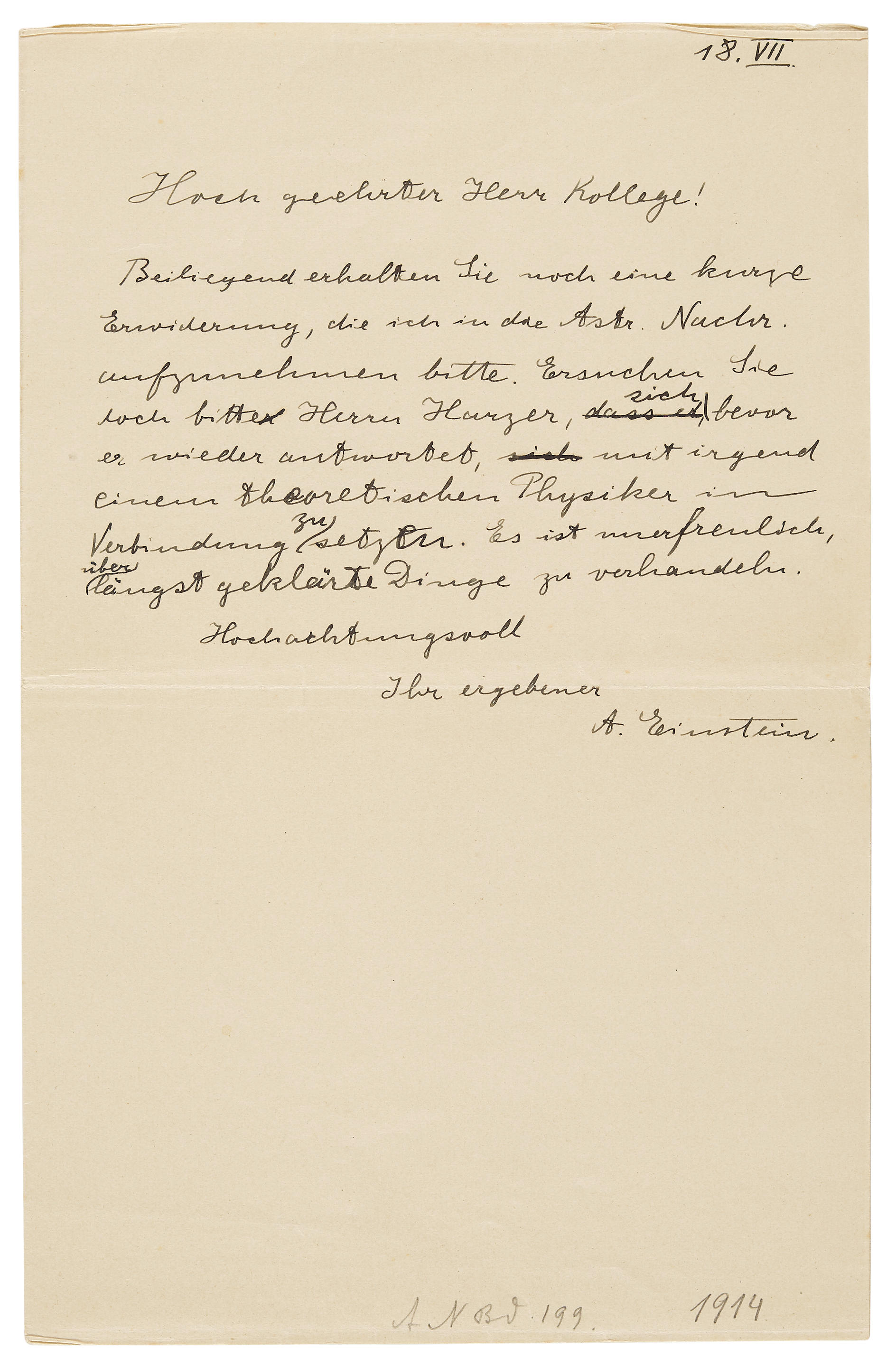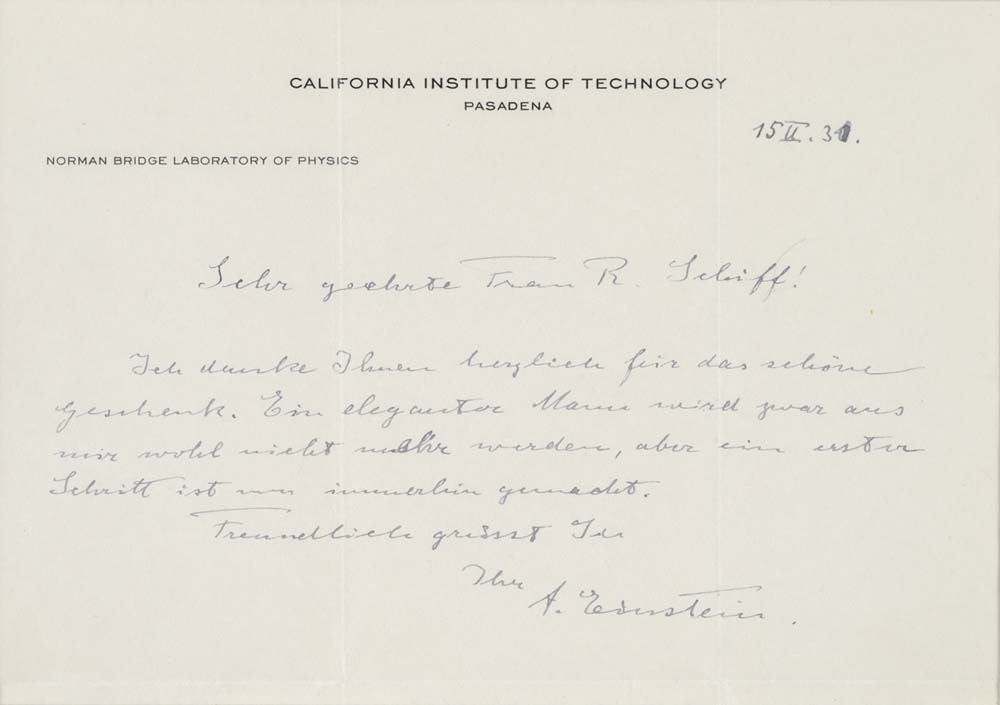EINSTEIN, Albert (1879-1955), Physicist . Autograph letter signed to Wilhelm Wien (1864-1928), Berlin, 15 June 1914. 3-1/2 pages, 4to. In German. With Wien’s 19 June 1914 typed letter in response.
EINSTEIN, Albert (1879-1955), Physicist . Autograph letter signed to Wilhelm Wien (1864-1928), Berlin, 15 June 1914. 3-1/2 pages, 4to. In German. With Wien’s 19 June 1914 typed letter in response. “Now the Theory of Relativity really is extended to arbitrarily moving systems” An important letter from Einstein’s early days in Berlin, showing his excitement over his recent breakthrough. “It is extraordinarily inspiring here in Berlin,” he writes. “I am not doing much myself at the moment, because I must have a breather from gravitation. In Zurich I had found the proof for covariance in the gravitation equations. Now the Theory of Relativity really is extended to arbitrarily moving systems.” Einstein’s declaration is a reference to work he undertook with Adriaan Fokker in 1913-14, which lead to the first treatment of gravitation in which general covariance is strictly obeyed. Though Einstein continued to perfect the formalism of his theory after this date, Einstein’s work with Fokker was decidedly one of the major theoretical breakthroughs along the path leading to the definitive theory of general relativity. Einstein and Fokker co-authored a paper “Die Nordstromsche Gravitationstheorie vom Standpunkt des absoluten Differentialkalkuls,” which appeared in 1914. Shortly after the date of this letter, Einstein in fact published an article in which he for the first time called his theory “The General Theory of Relativity.” Einstein makes his epochal statement in the context of a letter to his friend and colleague Wilhelm Wien, one of the “founding fathers” of the quantum revolution (who empirically determined the law of blackbody radiation). Reporting on matters at the Deutschen Physikalische Gesellschaft (Society of German Physicists), of which Einstein was the youngest member and soon-to-be president (in 1916, after a term of office by Max Planck), Einstein here tells Wien that Wien’s name was going to be put in nomination to be “first president at the first general assembly.” (A nomination which was apparently not successful, Wien only becoming president of the Society in 1918, immediately after Einstein.) In 1896 Wien empirically determined a distribution of blackbody radiation, which he formulated as “Wien’s law.” Max Planck shortly afterwards gave Wien’s law a theoretical basis (the Wien-Planck law) – an action which directly lead to his subsequent formulation of “Planck’s law” and “Planck’s constant” and the foundation of Quantum Theory. Wien was awarded the Nobel Prize in 1911 “for his discoveries regarding the laws governing the radiation of heat.” Published in Collected Papers of Albert Einstein , vol. 8, item 14; Wien’s reply is item 15.
EINSTEIN, Albert (1879-1955), Physicist . Autograph letter signed to Wilhelm Wien (1864-1928), Berlin, 15 June 1914. 3-1/2 pages, 4to. In German. With Wien’s 19 June 1914 typed letter in response.
EINSTEIN, Albert (1879-1955), Physicist . Autograph letter signed to Wilhelm Wien (1864-1928), Berlin, 15 June 1914. 3-1/2 pages, 4to. In German. With Wien’s 19 June 1914 typed letter in response. “Now the Theory of Relativity really is extended to arbitrarily moving systems” An important letter from Einstein’s early days in Berlin, showing his excitement over his recent breakthrough. “It is extraordinarily inspiring here in Berlin,” he writes. “I am not doing much myself at the moment, because I must have a breather from gravitation. In Zurich I had found the proof for covariance in the gravitation equations. Now the Theory of Relativity really is extended to arbitrarily moving systems.” Einstein’s declaration is a reference to work he undertook with Adriaan Fokker in 1913-14, which lead to the first treatment of gravitation in which general covariance is strictly obeyed. Though Einstein continued to perfect the formalism of his theory after this date, Einstein’s work with Fokker was decidedly one of the major theoretical breakthroughs along the path leading to the definitive theory of general relativity. Einstein and Fokker co-authored a paper “Die Nordstromsche Gravitationstheorie vom Standpunkt des absoluten Differentialkalkuls,” which appeared in 1914. Shortly after the date of this letter, Einstein in fact published an article in which he for the first time called his theory “The General Theory of Relativity.” Einstein makes his epochal statement in the context of a letter to his friend and colleague Wilhelm Wien, one of the “founding fathers” of the quantum revolution (who empirically determined the law of blackbody radiation). Reporting on matters at the Deutschen Physikalische Gesellschaft (Society of German Physicists), of which Einstein was the youngest member and soon-to-be president (in 1916, after a term of office by Max Planck), Einstein here tells Wien that Wien’s name was going to be put in nomination to be “first president at the first general assembly.” (A nomination which was apparently not successful, Wien only becoming president of the Society in 1918, immediately after Einstein.) In 1896 Wien empirically determined a distribution of blackbody radiation, which he formulated as “Wien’s law.” Max Planck shortly afterwards gave Wien’s law a theoretical basis (the Wien-Planck law) – an action which directly lead to his subsequent formulation of “Planck’s law” and “Planck’s constant” and the foundation of Quantum Theory. Wien was awarded the Nobel Prize in 1911 “for his discoveries regarding the laws governing the radiation of heat.” Published in Collected Papers of Albert Einstein , vol. 8, item 14; Wien’s reply is item 15.

.jpg)




.jpg)

.jpg)
.jpg)
.jpg)




Testen Sie LotSearch und seine Premium-Features 7 Tage - ohne Kosten!
Lassen Sie sich automatisch über neue Objekte in kommenden Auktionen benachrichtigen.
Suchauftrag anlegen